When walking into a Quinnipiac Men’s Ice Hockey game at the M&T Bank Arena for the famous “Beat Yale” game an immediate feeling of the competitive atmosphere washes over you. It’s as if you are being transported to a new world the second you feel the heat blasting from above when you walk through the first set of doors.
According to gobobcats.com, 3,178 fans filled the M&T Bank Arena dressed in blue and gold for this Quinnipiac vs. Yale matchup. The lines to get food were wrapped around the entrance and getting any form of a ticket was virtually impossible as they disappeared before you could click “buy now”. To put this into perspective, the tickets sold out as fast as when Thanos snapped his fingers in “Avengers Infinity War” and half of earths population immediately disappeared.
Now, for comparison, walking into a Bobcats women’s ice hockey “Beat Yale” game is the exact opposite. The men’s games foster a full population of 3,178 fans while for the women’s game, it was actually more like the population after Thanos snapped…but even less having only 1,297 fans according to gobobcats.com.
Entering the arena and you could walk right up to the concession stand and get that steaming hot bag of popcorn without a wait, the stadium is filled with only a few dedicated fans with only about half of them wearing the blue and gold and you can still get a ticket even if you show up halfway through the game.
“Some people make up the excuse of “it’s just not the same” and how men’s hockey is apparently so different than women’s. But it makes me wonder if they are one of the best teams in Division I, how could it be that much less interesting,” junior health science major Emma Halbert said.
Whatever the reason may be for this disparity, the statistics for the season show that this isn’t just the case for one game.

According to the USCHO Division I Hockey Attendance rankings for the 2022-2023 season, the men’s team at Quinnipiac brought in an average attendance of 2,968 people while the women’s team brought in an average of 526 people.
This sort of difference could possibly make sense if the men’s team was exponentially better than the women’s team, but that is just not the case.
At Quinnipiac University both the men’s and women’s ice hockey teams are ranked top ten nationally in the standings by the United States College Hockey Association in the Division I college hockey polls, showing that each team is at the highest level of competition in their field
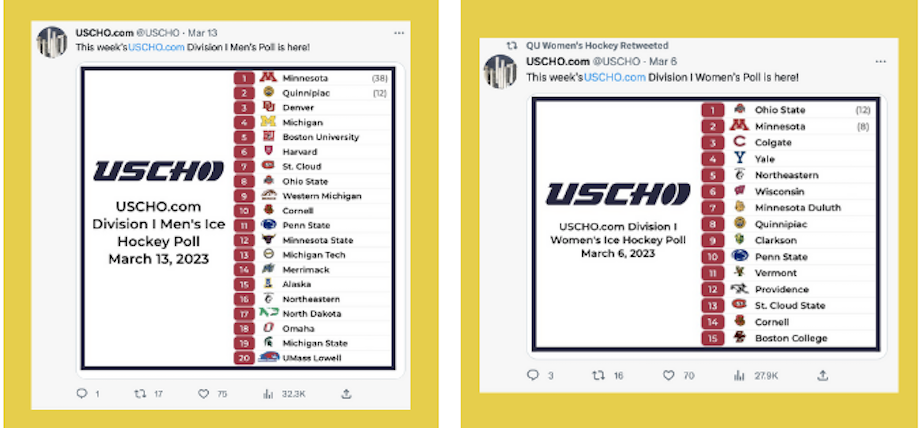
So….why does the men’s team get so much more attention than the women’s team does by fans?
Quinnipiac Athletics declined to comment on this subject.
However, many other people have different ideas as to what the cause could be.
Jacalyn Goulet, a sophomore marketing major believes that there may be equal promotion, but the culture is completely different between the two teams.
“Quinnipiac and its student media seems to promote both men and women’s hockey equally, but I don’t believe this has an effect on the differing support the teams receive from students and the community,” Goulet said.
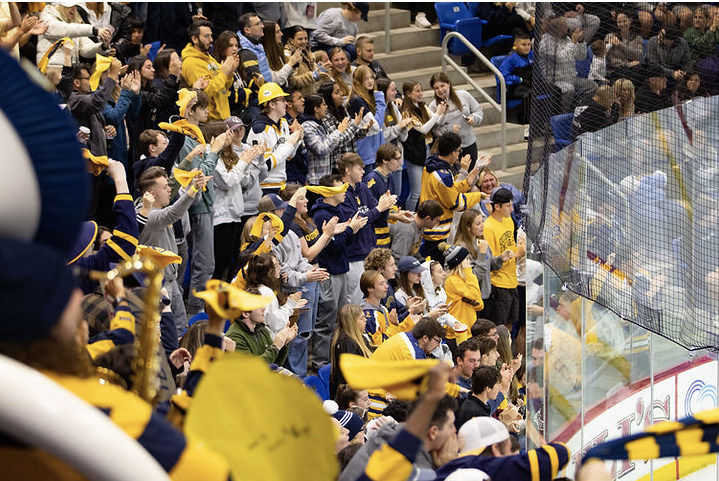
“I feel that the overall culture and media representation surrounding men’s and women’s sports often favors men’s sports, no matter the level. I think this, as well as the reputation the team has in the country, influences Quinnipiac students higher interest in men’s ice hockey.”
“I believe it is a hidden bias that people have of men’s sports over women’s sports. This is unfair and something needs to change. I also feel like the women’s games are not publicized the same as the men’s,” Halbert said.
And she isn’t the only person that thinks that the promotion of the women’s ice hockey team is less than that of the men’s.
Q30 hockey beat reporter David Maher also feels like the issues stem from the university and its athletics department.
“They were a Top 10 team, they played quality, nationally recognized and ranked opponents this year, and made the playoffs and they couldn’t get even a quarter of a section in the students end filled,” Maher said.
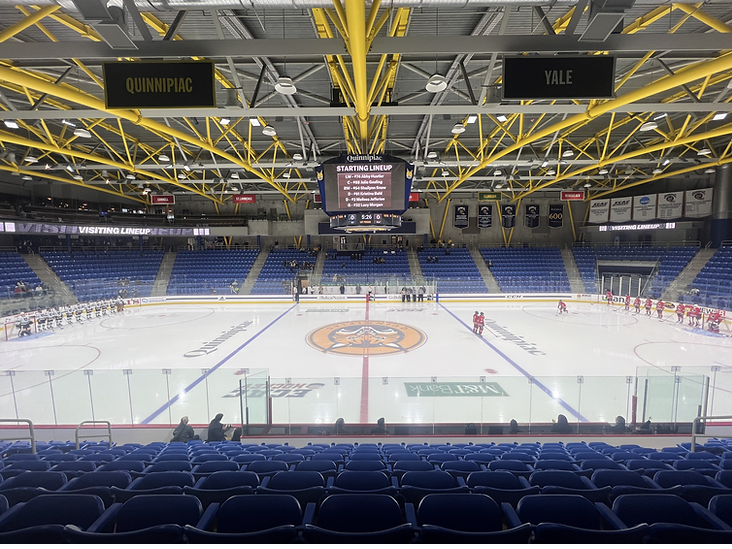
“When you have Top 10 hockey programs, there should be promotions from the school and the athletics department for both programs. I don’t think the school is doing enough, specifically, for the women’s program and needs to do a better job of promoting the team when they play these nationally ranked programs.”
This disparity of attendance and the issue surrounding promotional content for each team has even been taken to twitter by Quinnipiac faculty, with Molly Yanity, the department chair of journalism at Quinnipiac University, sharing her thoughts on attendance for the women’s ice hockey team’s home playoff game.
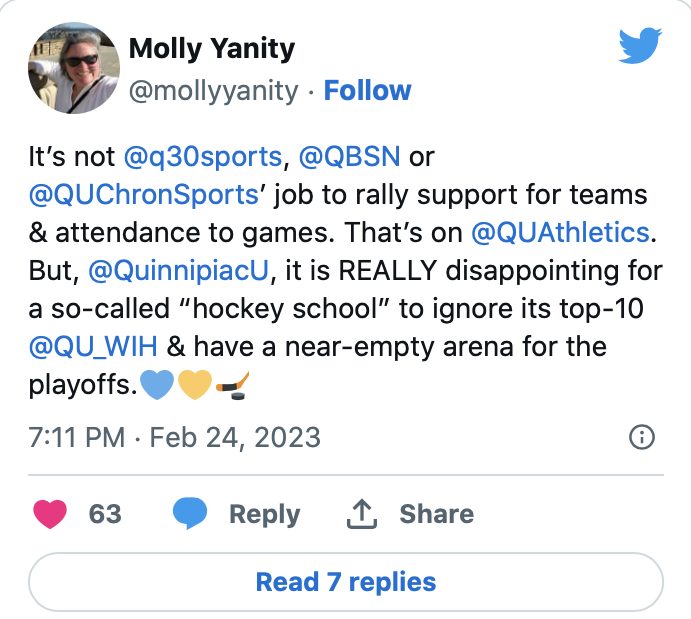
While many chalk it up to the athletics department and the school not doing their part, the athletics department has a different mindset.
Former Quinnipiac Assistant Director of Athletic Communications and Women’s Ice Hockey SID, Maggie Pruitt, has seen the struggles that the Quinnipiac Athletics Department has and how that affects their ability to do more.
“When you look at it from afar you think they’re not really doing much to get people here and we could do more giveaways and stuff,” Pruitt said. “Those are always discussions going on, it’s also about man power and money and sometimes those things just aren’t there and they’re not there for the men’s team either, it’s not like they’re picking and choosing.”
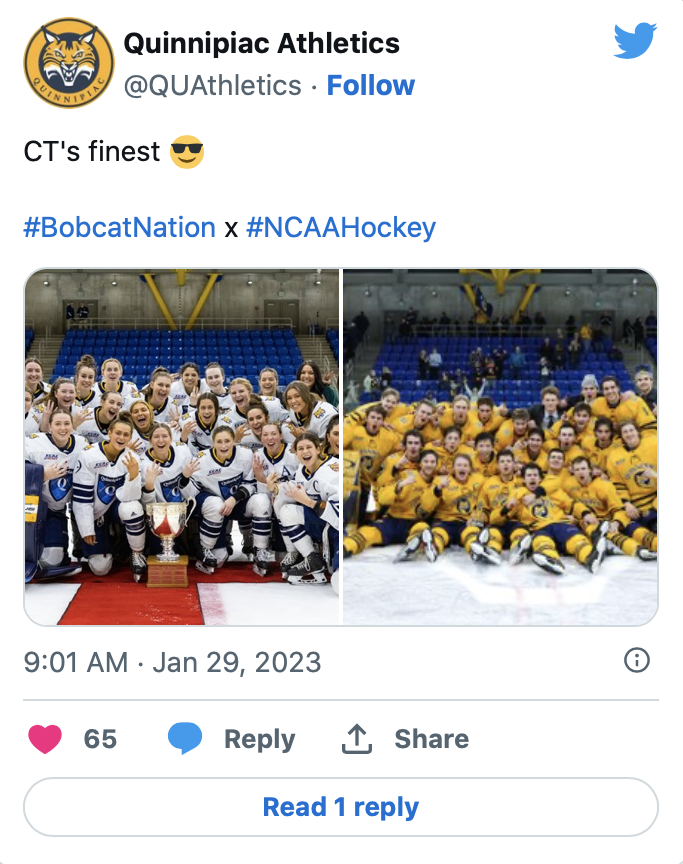
While the money and staffing is not where athletics would like it to be, Pruitt says they use it equally amongst all of the Division I teams on campus.
“The men don’t get more than the women’s team,”Pruitt said. “They don’t get special treatment from our athletic department, they don’t get more put into them, it’s honestly just unfortunately how it is.”
And even though the athletics department treats each team equally, Pruitt has seen the underlying bias towards men’s sports in the eyes of the students on campus.
“I saw a lot of different things when I was there when it comes to students,” Pruitt said. “I would say students who like sports, enjoy that atmosphere and want to be a part of something like that, they know and think of the men’s team and I would say the vast majority of students don’t really know much about the women’s team.”
And that lack of knowledge became clear to Pruitt last year, which was her last season working with the Bobcats women’s ice hockey team, when the department did a “dorm storm” before they hosted the first round of the women’s ice hockey playoffs and she heard jarring comments from the students.
“The students who maybe were interested didn’t really know about the women, I think one person even said they didn’t realize we had a women’s team or knew that they played on the rink at York Hill,” Pruitt said.
Now, everyone who goes to Quinnipiac University knows about the men’s hockey team and if they don’t know before, they are immediately cultured into it by almost every single tour guide or orientation leader when they get there. The women’s team clearly does not have that luxury.
Overall, Pruitt wishes that there was an easy way to fix the gap between the teams from an athletics department perspective, but from her experience there just isn’t a simple solution.
“It would take a huge team of people to bring students to a women’s game,” Pruitt said. “It would take a lot of work and unfortunately that marketing and athletic communications staff is very understaffed and that is a big undertaking and requires a lot of money.”
But, even though the Bobcats specific staff may be lacking numbers and money, Quinnipiac University is not the only school that faces this disparity in attendance rates. Taking a look at a majority of the programs in the Eastern College Athletic Conference, which is the conference that Quinnipiac competes in, there is a similar trend amongst every school.
Looking at the numbers for the ECAC attendance rates based on the USCHO rankings for the 2022-2023 season, it is evident that the men’s teams, overall, get a lot more attention than the women’s teams do at every single school in the conference. In the chart, the blue lines represent the men’s attendance numbers while the yellow lines represent the women’s attendance for that same school.
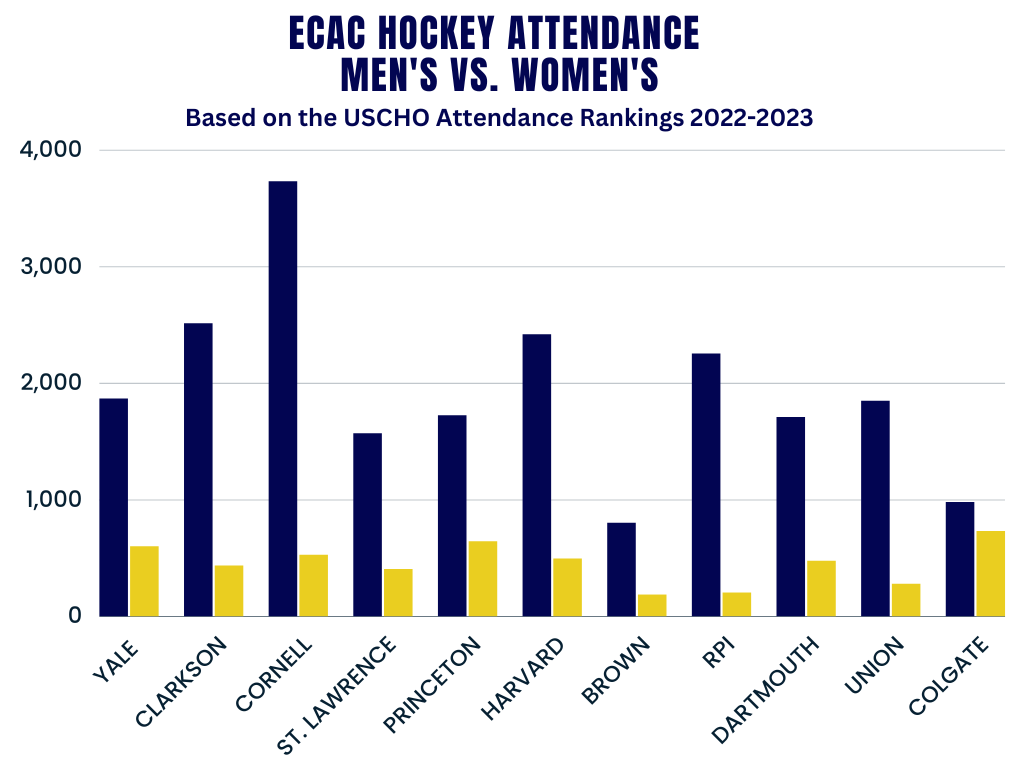
So, while Quinnipiac averages 2,968 people for the men’s games and 526 for the women’s games, this is not out of the ordinary as every other school has the same disparity. Cornell averages 3,730 people for their men’s games and only 552 people for their women’s games and RPI averages 2,251 for men’s and 203 for women’s.
The numbers don’t lie and while this is an issue that is visible all over the ECAC hockey conference, hockey is not the only sport that has this disparity.
Now getting back to Thanos and his snap as a metaphor for the attendance rates at men’s versus women’s sporting events, that’s not only for hockey either.
Just look at the difference in attendance at the Quinnipiac men’s basketball senior day versus the women’s basketball senior day. The pre and post Thanos snap vibes are evident when looking at these images side by side.
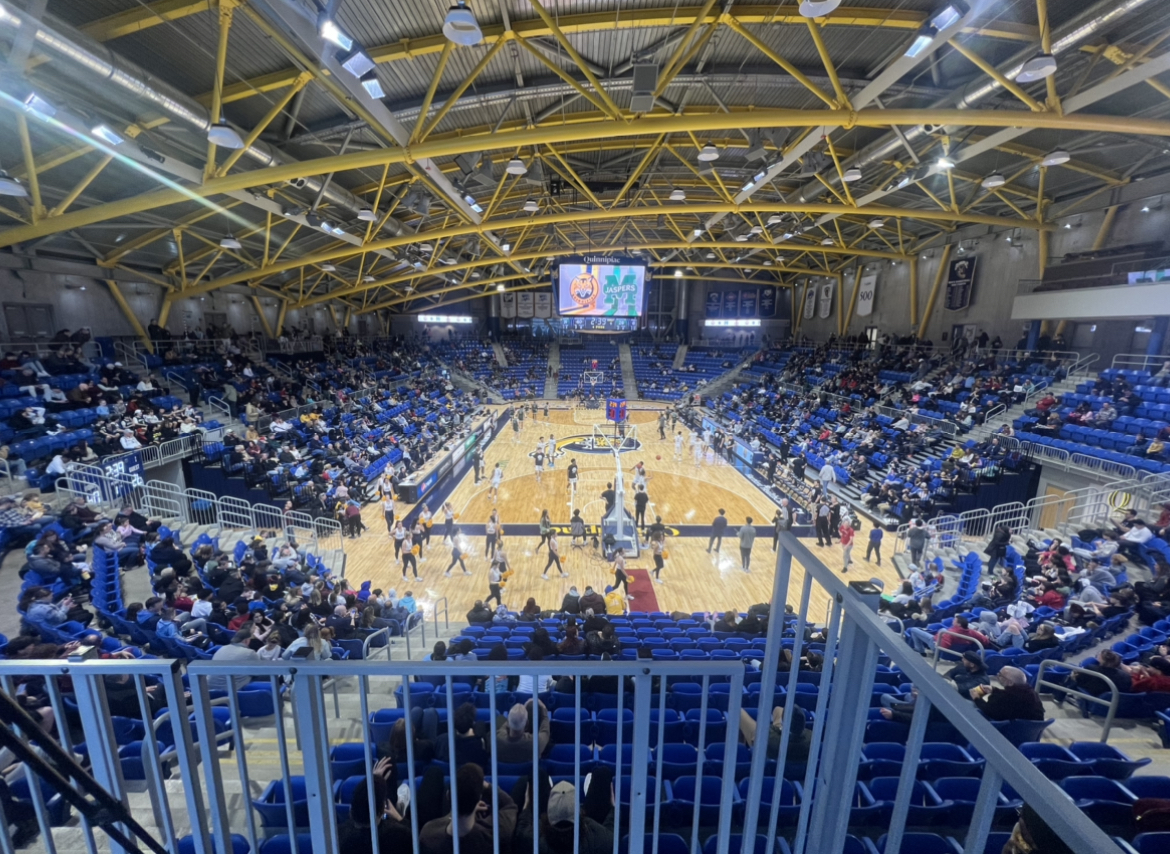

And this isn’t even the worst of it.
Some believe that maybe this dates back to gaining acceptance for women playing sports. The world is still grasping how competitive and equal to men’s athletics women’s sports really are and that could play a role in why almost every sport you can name, has this attendance disparity.
At Quinnipiac University even the coaches recognize the disparity and know there is more that can be done.
Quinnipiac women’s basketball head coach, Tricia Fabbri, talked about this saying,
“We have been a tradition of winning for ten years. It will be my number one priority as soon as the season is over, sitting down with Cass (the women’s ice hockey head coach).”
While Fabbri plans to meet with the Quinnipiac women’s ice hockey head coach and discuss what they can do on their ends to promote their successful teams, she goes deeper into how they need to level the attendance playing field.
“We need to make an effort from our office and from the athletic department,” Fabbri said.
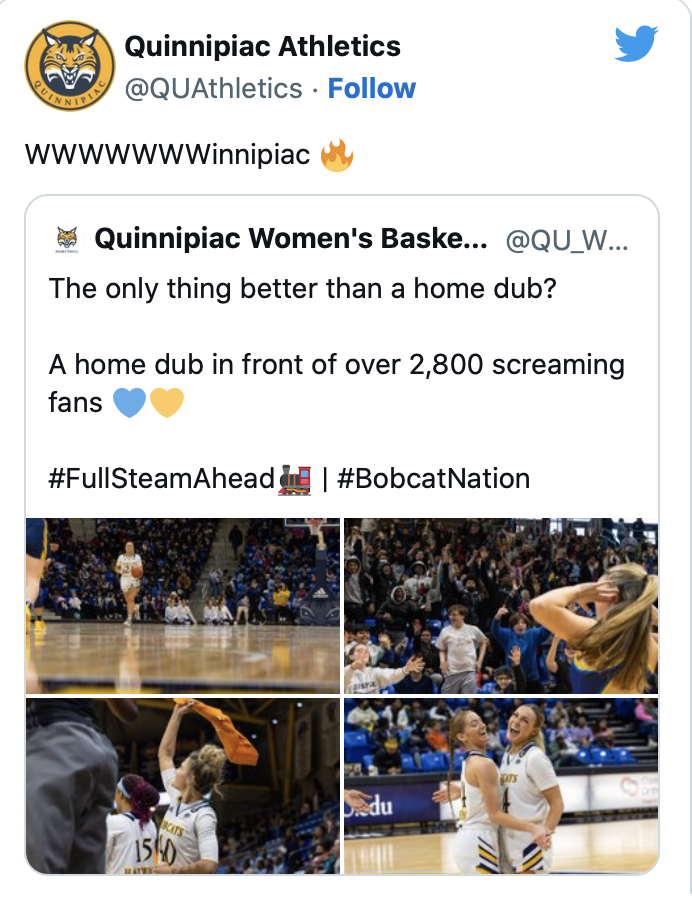
“We put out a great team and we need to get the following, and we need to roll up our sleeves, and we need to do a better job in the off-season and really devise a great strategic plan on how to get support, better support.”
“It’s been good but we want it better and that is really on my plate as my number one priority with Cass because we have been winners, consistent winners, for years and years and years and these young ladies deserve playing in front of crowds, real big crowds.”
While things may be getting better in the scope of women’s sports, this is still a problem that is very clear through the statistics and through the environment surrounding men’s vs. women’s teams.
From fans to beat reporters to professors to former SID’s and to coaches or even to people passing through, it is evident that there is much more work to be done at Quinnipiac to make the attendance rates deservedly equal for the successful and talented women’s athletics on their campus.
